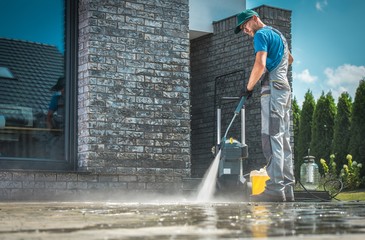Your driveway should be a safe and welcoming entrance to your home. It should also be well-designed to ensure that water drains away from the pavement effectively. SC Driveway Paving Charleston can add to the resale value of your property and enhance your overall curb appeal. Driveway paving materials can be poured concrete, asphalt, pavers, or gravel.

If you want a long-lasting, durable, good-looking asphalt driveway, you must build it on a solid foundation. That’s why sub-grading is a critical first step in any paving job.
The subgrade is the native soil under a roadway, pavement, or driveway. It’s also known as the formation level. Ideally, the subgrade is structurally sound and properly compacted, but this is only sometimes possible.
The subgrade is often weakened by poor construction techniques and climatic conditions such as excessive moisture or freezing/thawing cycles. The subgrade must have a high load-bearing capacity and be able to resist volume changes. Otherwise, it can lead to settlement and damage to the completed pavement structure.
The ideal sub-grade is a well-compacted, dense material free of soft spots, ruts, and depressions. It must be strong enough to support the traffic loads transmitted through the complete pavement, including truck traffic. , a soil test should be conducted, and a professional engineer should review the results To ensure that your sub-grade can meet these requirements.
A common technique for preparing the subgrade is to install a geotextile fabric on the ground surface. This inexpensive step is often overlooked and can make a huge difference in the longevity of your new driveway.
During the R&R process, the old driveway will be completely ripped out to the subgrade, covered with the geotextile fabric, and rebuilt with 10 inches of runner-crush stone in two lifts. Dependable Paving uses 1″ minus stone, similar to runner-crush, but has been screened to allow stones 1 inch and smaller to pass through. The sub-base should be spread evenly and compacted thoroughly, and the sub-grade must be firmly in place before proceeding to the binder course.
As its name suggests, the sub-base is the material layer underneath your final paving surface. It’s typically made from granular materials, such as crushed stone or gravel, and is installed at the base of your pavement before the asphalt is laid. It acts as the primary load-bearer, spreading the pressure from the Paving onto the underlying soil or aggregate.
It also helps prevent water from pooling beneath the Paving and eroding it over time, reducing the amount of moisture retained in the ground and causing it to become saturated and damp. It is particularly important on steeper gradients, where drainage problems can occur.
Sub-base is important because it is a key component in the overall structural integrity of your driveway. A faulty or low-quality sub-base is the primary reason that many people find that their new paved surfaces begin to shift, sink, and crack over time.
Using a high-quality sub-base, such as MOT Type 1 (or ‘DOT’ type in the US) is important. This crushed stone has been approved by the Ministry of Transport and is designed for use on roads and highways. It’s strong and stable, making it ideal for supporting Paving. It also drains well, which prevents water accumulation beneath your finished Paving.
A proper sub-base is usually 4 inches thick and must be carefully fine-graded and compacted with vibratory compaction equipment. Dependable Paving typically uses two lifts of sub-base on every paving job, starting with 8 inches of minus-4 runner-crush and finishing with a 2-inch bang of regular runner-crush.
The binder course is the first layer of asphalt installed. Also called the base coat, this layer rests on the prepared runner-crush stone base and utilizes bigger aggregate pieces than those used in all other coatings. This layer is very important as it is the load-bearing section of the pavement. Hence, it must be strong enough to handle heavy vehicles for as long as the roadway will last.
The paving company must also use a high-quality binder for this Course. Several tests are carried out to ensure the asphalt binder is good quality. These include the needle penetration test and its variations, which measure how far a lightweight needle can penetrate an asphalt mix. These empirical tests have serious limitations but can indicate an asphalt binder’s stiffness.
Asphalt binders are complex materials that are difficult to test and specify. As a result, there is a major effort to develop standard test methods and effective specifications.
For instance, the Strategic Highway Research Program (SHRP) developed a system of performance grading specifications known as Superpave in the early 1990s. These incorporated climate and pavement temperature data to determine which asphalt binder should be used on a specific project. A performance-graded binder specified for a site must meet a minimum reliability of 98% at both its maximum and lowest design temperatures.
An alternative to using a traditional asphalt binder is recycled rubberized concrete (RAC). This material is made by blending ground-up tires with conventional asphalt materials to create an asphalt product that can be used for roads and parking lots. RAC is an environmentally friendly, low-cost material with the same benefits as traditional asphalt.
A full-depth two-layer paving system is ideal for asphalt driveways because it offers strength, flexibility, and durability. The first Course of the 25mm Base Course is installed and compacted; once it’s cooled, a 9.5mm Wearing Course is laid and rolled, then consolidated again to create the final surface of your new driveway. This technique results in a stronger, more durable, and longer-lasting finish than any other type of paving material.
A concrete apron is sometimes used at the end of a driveway connecting to a road. It helps prevent any surface distortion where the driveway meets the road or another type of material. However, Dependable Paving always recommends an asphalt apron as it provides superior performance and durability over a concrete one.
The topmost layer of the pavement is called the surface or wearing Course. This layer is designed to come into contact with traffic and provides a smooth, noise-reducing, and visually pleasing driving surface. This asphalt is usually made from a finer aggregate than the binder and also incorporates some stone (rather than being an all-sand mix) to reduce the potential for segregation and low in-place density that can result in punching depressions, rutting, and premature failure.
It is when the paving contractor repairs any serious holes, potholes, or other trouble areas with Hot Mix Asphalt and levels it out before the finishing Course is applied. The leveling course is also a great opportunity to consider using porous asphalt. It uses coarse aggregates that allow rain and melting snow to drain through the pavement instead of pooling on top of it. It is a great way to help protect the environment and reduce your water bill!
During this phase, the sub-base is compacted and graded to ensure it’s strong enough for the top layer of asphalt. Soft spots may also be discovered at this time, and steps will be taken to address them before moving on to the surfacing stage.
Once the paving process is complete, it’s important to have good drainage performance. Any water that pools on or near the surface can cause damage in various ways. The best way to prevent this is to have good grading on the new asphalt so that water runs off it and down into drainage channels or other areas.
In addition, the surface should be properly sloped so it doesn’t pool or run off onto adjacent driveways, sidewalks, or roads. It will improve weight transfer and allow for a more comfortable drive over the surface.
A transitional zone is a region that cannot be assigned to either urban or rural space use due to its diverse method of use. This study identified the location and shape of such a zone in Olsztyn and its outskirts, which are directly exposed to the impact of urbanization pressure.
The study’s goal was to define the transitional zone by using a mathematical approach based on fuzzy models. The results show that the defining characteristic of such a zone is that its functions reach the degree of membership interval of 0.5. This value, which represents the border between the urban and the rural locale, can be defined as the complement to u = 1 of the urban function. The method developed is a tool for identifying and locating the transitional zone employing topographic maps, enabling the preparation of cartographic compilations that present the full image of the study area.

